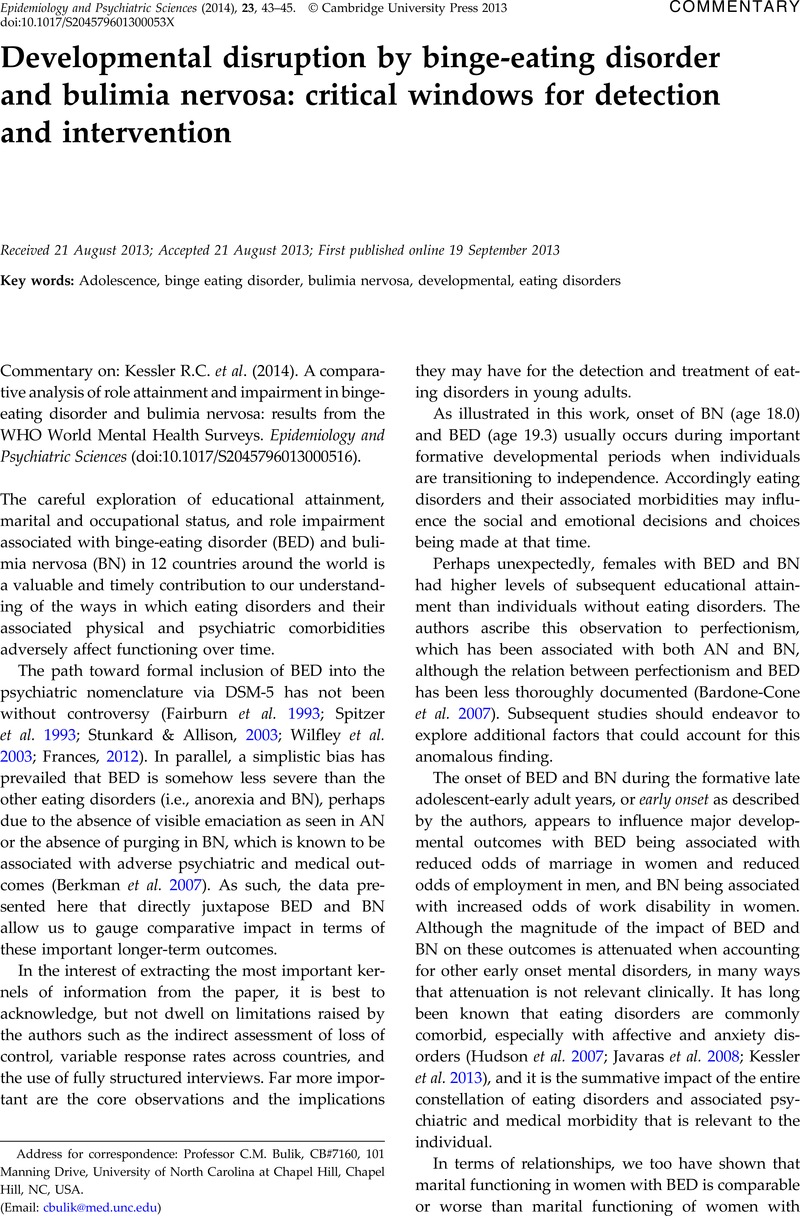No CrossRef data available.
Article contents
Developmental disruption by binge-eating disorder and bulimia nervosa: critical windows for detection and intervention
Published online by Cambridge University Press: 19 September 2013
Abstract
An abstract is not available for this content so a preview has been provided. Please use the Get access link above for information on how to access this content.

Information
- Type
- Commentaries
- Information
- Copyright
- Copyright © Cambridge University Press 2013
References
Bardone-Cone, AM, Wonderlich, SA, Frost, RO, Bulik, CM, Mitchell, JE, Uppala, S, Simonich, H (2007). Perfectionism and eating disorders: current status and future directions. Clinical Psychology Review 27, 384–405.CrossRefGoogle ScholarPubMed
Berg, KC, Crosby, RD, Cao, L, Peterson, CB, Engel, SG, Mitchell, JE, Wonderlich, SA (2013). Facets of negative affect prior to and following binge-only, purge-only, and binge/purge events in women with bulimia nervosa. Journal of Abnormal Psychology 122, 111–118.CrossRefGoogle ScholarPubMed
Berkman, ND, Lohr, KN, Bulik, CM (2007). Outcomes of eating disorders: a systematic review of the literature. International Journal of Eating Disorders 40, 293–309.CrossRefGoogle ScholarPubMed
Dooley-Hash, S, Banker, JD, Walton, MA, Ginsburg, Y, Cunningham, RM (2012). The prevalence and correlates of eating disorders among emergency department patients aged 14–20 years. International Journal of Eating Disorders 45, 883–890.CrossRefGoogle ScholarPubMed
Fairburn, CG, Welch, SL, Hay, PJ (1993). The classification of recurrent overeating: the “binge eating disorder” proposal. International Journal of Eating Disorders 13, 155–159.3.0.CO;2-T>CrossRefGoogle ScholarPubMed
Frances, A (2012). DSM-5 Is a Guide, Not a Bible: Simply Ignore Its 10 Worst Changes. Huff Post Science http://www.huffingtonpost.com/allen-frances/dsm-5_b_2227626.html.Google Scholar
Haedt-Matt, AA, Keel, PK (2011). Revisiting the affect regulation model of binge eating: a meta-analysis of studies using ecological momentary assessment. Psychological Bulletin 137, 660–681.CrossRefGoogle ScholarPubMed
Hudson, JI, Lalonde, JK, Berry, JM, Pindyck, LJ, Bulik, CM, Crow, SJ, McElroy, SL, Laird, NM, Tsuang, MT, Walsh, BT, Rosenthal, NR, Pope, HG Jr. (2006). Binge-eating disorder as a distinct familial phenotype in obese individuals. Archives of General Psychiatry 63, 313–319.CrossRefGoogle ScholarPubMed
Hudson, JI, Hiripi, E, Pope, HG Jr., Kessler, RC (2007). The prevalence and correlates of eating disorders in the National Comorbidity Survey Replication. Biological Psychiatry 61, 348–358.CrossRefGoogle ScholarPubMed
Hudson, JI, Lalonde, JK, Coit, CE, Tsuang, MT, McElroy, SL, Crow, SJ, Bulik, CM, Hudson, MS, Yanovski, JA, Rosenthal, NR, Pope, HG Jr. (2010). Longitudinal study of the diagnosis of components of the metabolic syndrome in individuals with binge-eating disorder. American Journal of Clinical Nutrition 91, 1568–1573.CrossRefGoogle ScholarPubMed
Javaras, KN, Pope, HG, Lalonde, JK, Roberts, JL, Nillni, YI, Laird, NM, Bulik, CM, Crow, SJ, McElroy, SL, Walsh, BT, Tsuang, MT, Rosenthal, NR, Hudson, JI (2008). Co-occurrence of binge eating disorder with psychiatric and medical disorders. Journal of Clinical Psychiatry 69, 266–273.CrossRefGoogle ScholarPubMed
Kessler, RC, Berglund, PA, Chiu, WT, Deitz, AC, Hudson, JI, Shahly, V, Aguilar-Gaxiola, S, Alonso, J, Angermeyer, MC, Benjet, C, Bruffaerts, R, de Girolamo, G, de Graaf, R, Maria Haro, J, Kovess-Masfety, V, O'Neill, S, Posada-Villa, J, Sasu, C, Scott, K, Viana, MC, Xavier, M (2013). The prevalence and correlates of binge eating disorder in the World Health Organization World Mental Health Surveys. Biological Psychiatry 73, 904–914.CrossRefGoogle ScholarPubMed
Spitzer, RL, Stunkard, A, Yanovski, S, Marcus, MD, Wadden, T, Wing, R, Mitchell, J, Hasin, D (1993). Binge eating disorder should be included in DSM- IV: a reply to Fairburn et al.'s “The classification of recurrent overeating: the binge eating disorder proposal”. International Journal of Eating Disorders 13, 161–169.3.0.CO;2-R>CrossRefGoogle Scholar
Stunkard, AJ, Allison, KC (2003). Binge eating disorder: disorder or marker? International Journal of Eating Disorders 34 (Suppl.), S107–S116.CrossRefGoogle ScholarPubMed
Trent, SA, Moreira, ME, Colwell, CB, Mehler, PS (2013). ED management of patients with eating disorders. American Journal of Emergency Medicine 31, 859–865.CrossRefGoogle ScholarPubMed
Whisman, MA, Dementyeva, A, Baucom, DH, Bulik, CM (2012). Marital functioning and binge eating disorder in married women. International Journal of Eating Disorders 45, 385–389.CrossRefGoogle ScholarPubMed
Whiteside, U, Chen, E, Neighbors, C, Hunter, D, Lo, T, Larimer, M (2007). Difficulties regulating emotions: Do binge eaters have fewer strategies to modulate and tolerate negative affect? Eating Behaviors 8, 162–169.CrossRefGoogle ScholarPubMed
Wilfley, DE, Wilson, GT, Agras, WS (2003). The clinical significance of binge eating disorder. International Journal of Eating Disorders 34 (Suppl.), S96–S106.CrossRefGoogle ScholarPubMed

